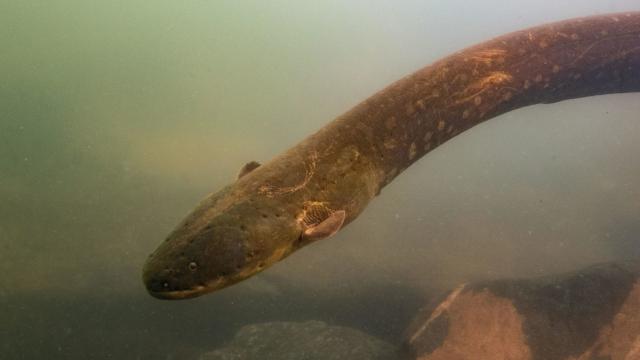Genetic data has revealed several distinct electric eel species living throughout South America, including the most shocking eel (and animal) discovered yet.
Scientists have assumed that the electric eel comprised a single species, ever since taxonomist Carl Linnaeus first described the creature 250 years ago. But researchers examining specimens from across South America have revealed that eels found in different waters diverge in shape, genetics, and even their ability to produce electric shocks. Electric eels secretly being multiple species all along only confirms that there’s a ton of biodiversity in the world that we don’t yet know about.
“The discovery of hidden species diversity on such an eye-catching (more than 2.5 metres long) and long-known (described 250 years ago) organism… indicates that an enormous amount of species are waiting to be discovered in the Amazon rainforest,” C. David de Santana, the study’s first author from the National Museum of Natural History in Washington, D.C., told Gizmodo in an email. “Many of which may harbour cure for diseases or inspire technological innovations, reinforcing the critical need to protect Earth’s hotspots of biodiversity.”
Electric eels are a widespread and charismatic fish that haunt South American freshwaters. Electricity is a crucial component of all life, but electric fish have a specialised organ made from electric current-generating cells that work much like flashlight batteries, where adding more in series makes the light (or in this case, the shock) brighter. Eels use these organs to move around and to stun their prey.
The researchers examined 107 electric eels taken from waters across northern South America, measuring different parts of their body and analysing their DNA. The fish look similar, differing mainly in the shape of their head. But genetic analysis revealed that electric eels actually comprise three species whose mitochondrial DNA — DNA contained in the cells’ powerhouse, separate from the identity-determining nuclear DNA — differed more than than humans’ mitochondrial DNA differs from that of chimps, de Santana explained.
The researchers proposed naming the three species Electrophorus voltai, Electrophorus electricus, and Electrophorus varii, and published their species descriptions in the journal Nature Communications.
The three species differ in more than just genetics. E. varii lives in lowland regions below sea level, in muddy water that conducts electricity well, while E. electricus and E. voltai inhabit clearer water in higher-altitude regions in Guyana and Brazil, respectively.
The analysis also revealed that E. voltai could produce shocks up to 860 volts, higher than has been measured for electric eels or any other organism before. The third rail powering New York City’s subway system carries 625 volts, while electric chairs used for executions produce over 2,000 volts.
It’s important to fully understand the biodiversity of these tropical fresh waters, said James Albert, a biologist at the University of Louisiana at Lafayette who was not involved in the study.
The Amazonia rivers are “an incredibly rich and dense concentration of species in a relatively small habitat volume,” he told Gizmodo. Determining what species exist is an important step in protecting them from human development, which is already wreaking havoc on the Amazon’s land. Albert also noted that many of the paper’s authors were Brazilian, showing that scientists there are committed to understanding and protecting their country’s biodiversity. He said he hoped to see similar organising of scientists studying tropical wildernesses in Africa and Southeast Asia.
De Santana pointed out that this research is based on only 107 specimens, and that more work would be needed to verify some of the hypotheses raised in the paper, such as why the different species produce voltages of varying strengths.
Biodiversity extends far beyond what we can see with our eyes — what seems like one species might actually be multiple populations that are as different as humans are from chimps. Losing habitats with high concentrations of biodiversity could lead to the extinctions of fascinating species we don’t even know exist yet.
